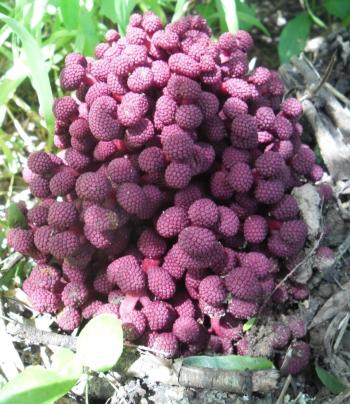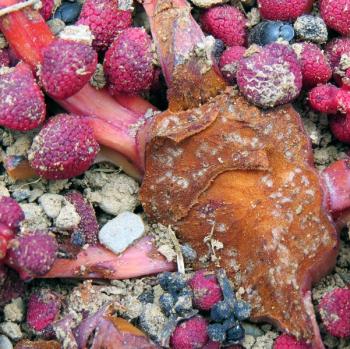Sarcophyte sanguinea subsp. sanguinea
Sarcophyte sanguinea Sparrm. subsp. sanguinea
Family: Balanophoraceae
Common names: wolwekos (Afr.); ihlule, umavumbuka (isiZulu)
Introduction
Sarcophyte sanguinea subsp. sanguinea is a parasitic plant that occurs on the roots of trees and shrubs, especially on African acacias (Vachellia species). This plant has a foul smell that attracts a number of different insects and its striking red colour, creates an easier way for attracting pollinators from a distance.

Description
Description
This plant species resembles fungi, rather than flowering plants. It is a reddish, fleshy parasite with tuberous roots. It is dioecious, i.e. male and female flowers are on separate plants. The male plant usually grows up to 300 mm high, whereas the female plant is shorter. The leaves are reduced to scales. The inflorescence is branched with the male inflorescence narrower and taller than the female, which is shorter, denser, rounder and fleshy.

The male flowers have white anthers that open by apical pores and release masses of smooth and oval-shaped pollen.

The female flowers consist of peltate, sessile stigmas just above the ovaries, that are embedded in a common, swollen receptacle. A single receptacle accommodates up to 200 individual florets. At least 250 of the receptacles make up an inflorescence. Thus, over 50 000 florets may be found in a single inflorescence. Female florets expose only flattened stigmas to receive pollen from pollinators. The stigmas are almost less than 1 mm in diameter. The fruit is a compound, syncarp, with each individual fruit a pseudo-berry. It can be found flowering almost throughout the year.
Conservation Status
Status
Sarcophyte sanguinea subsp. sanguinea is of Least Concern (LC) according to the Red List of South African plants. It is, therefore, considered not to be under any immediate risk of extinction.
Distribution and habitat
Distribution description
Sarcophyte sanguinea subsp. sanguinea occurs in summer rainfall regions of eastern and southern Africa, from Ethiopia and Somalia in the north, southwards to South Africa. It is not endemic to South Africa, but it is widely distributed in the Eastern Cape, KwaZulu-Natal, Limpopo and Mpumalanga Provinces.

Derivation of name and historical aspects
History
The name Sarcophyte, meaning ‘flesh/fleshy plant’, is derived from the Greek words sarx, meaning ‘flesh’ and phyton, meaning ‘plant’. Sanguinea, means ‘blood-red’ and refers to the red colour of the plant.
There is another subspecies known as Sarcophyte sanguinea subsp. piriei Hutch. The subspecies piriei, unlike subsp. sanguinea, has a fruity smell. Further distinguishing characters include the male inflorescences which are up to 400 mm tall (female ones are shorter); flesh-coloured to purplish red except for the pale bracts; tepals of male flowers that are about twice as long as the stamens; pollen grains that are smooth. The subsp. piriei is widely distributed in Kenya, Tanzania, Zambia, Malawi and Mozambique.

Ecology
Ecology
Sarcophyte sanguinea occurs in woodlands, riverine forests, thickets and bordering savanna, from sea-level up to 2 000 m altitude. It is a holoparasite occurring on the roots of a wide variety of trees, including Vachellia (= Acacia), Hyphaene, Commiphora, Ficus, Faidherbia albida and Mimusops obtusifolia. The pollinators are attracted by its foul smell and striking red colour.

Uses
Use
The rural women of the Mbazwana area in KwaZulu-Natal Province (South Africa) use the stem to treat wounds, diarrhoea and dysentery. This plant is also used traditionally to treat dysentery, sore throat, swollen glands, and irregular menstruation. It is applied externally to treat bruises and toothache, and a whole plant decoction is drunk to treat cancer in Tanzania.
Growing Sarcophyte sanguinea subsp. sanguinea
Grow
Although the authors have no experience in growing this plant, it is apparently easy to propagate by seed.
References
- De Wet, H., et al. 2008. An ethnopharmacological investigation of home grown plants used for treating diarrhoea and wounds infections in the Mbazwana area, Maputaland. South African Journal of Botany 74: 365, 366.
- Nkwanyana, M.N. 2013. An ethnobotanical and antidiarrhoeal investigation of plants used traditionally in the Maputaland area homesteads. M.Sc. thesis, University of Zululand.
- Pooley, E. 2005. A field guide to wild flowers KwaZulu-Natal and the eastern regions. The Flora Publications Trust, Durban.
- Raimondo, D., Von Staden, L., Foden, W., Victor, J.E., Helme, N.A., Turner, R.C., Kamundi, D.A. & Manyama, P.A. (eds) 2009. Red list of South African plants. Strelitzia 25. South African National Biodiversity Institute, Pretoria.
- Schmelzer, G.H. 2012. Sarcophyte sanguinea Sparrm. In G.H. Schmelzer & A. Gurib-Fakim, Prota 11(2): Medicinal plants/Plantes médicinales 2. PROTA, Wageningen, Netherlands.
- Thulin, M. 1999. Flora of Somalia, Volume 2. http://plants.jstor.org/stable/10.5555/al.ap.flora.flos000457. Accessed on 25 July 2017.
- Visser, J. 1981. South African parasitic flowering plants. Juta, Cape Town.
- Williams, V.L., Raimondo, D., Crouch, N.R., Cunningham, A.B., Scott-Shaw, C.R., Lötter, M. & Ngwenya, A.M. 2008. Sarcophyte sanguinea Sparrm. subsp. sanguinea. National Assessment: Red List of South African plants version 2017.1. Accessed on 2017/07/25
Credits
Mduduzi Nkwanyana and Aluwani Tshiila
National Herbarium
September 2017
Plant Attributes:
Plant Type: Parasitic
SA Distribution: Eastern Cape, KwaZulu-Natal, Limpopo, Mpumalanga
Soil type:
Flowering season: Sporadic/All year
PH:
Flower colour: Red, White
Aspect:
Gardening skill: Challenging
Special Features:
Horticultural zones








Rate this article
Article well written and informative
Rate this plant
Is this an interesting plant?
Login to add your Comment
Back to topNot registered yet? Click here to register.